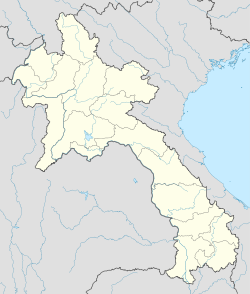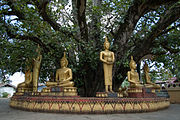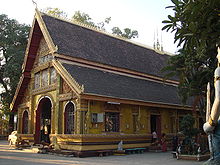- Vientiane
-
This article is about the city. For other administrative entities see Vientiane Prefecture and Vientiane Province.
Vientiane
ວຽງຈັນ— Capital City — Vientiane Coordinates: 17°58′00″N 102°36′00″E / 17.9666667°N 102.6°ECoordinates: 17°58′00″N 102°36′00″E / 17.9666667°N 102.6°E Country Laos Settled 9th Century AD[1] Government - Mayor Sombath Yialiheu Elevation 174 m (570 ft) Population (7/2009 est) - Total 754,000 Vientiane (pronounced /vjɛnˈtjɑːn/, Lao ວຽງຈັນ Wiang-jun; Thai เวียงจันทน์ Wiang-chan, IPA: [wíəŋ tɕàn]; literally "City of Sandalwood") is the capital and largest city of Laos, situated in the Mekong river. Vientiane became the capital in 1563 due to fears of a Burmese invasion.[2] During French rule, Vientiane was the administrative capital and due to economic growth in recent times, it has become the economic centre of Laos.
The estimated population of the city is 754,000 (2009)[3] while the number of people living in the Vientiane metropolitan area (the entire Vientiane Prefecture and parts of Vientiane Province) is believed to be over 730,000. The city hosted the 25th Southeast Asian Games in December 2009 celebrating the 50 years of SEA Games.
Contents
Origin of the name
The name of the city is derived from Pali, the liturgical language of Theravada Buddhism. Its original meaning is "royal sandalwood grove" or "city of sandalwood", this tree being highly valued in classical India for its fragrance. In modern Lao, the meaning of Vientiane is ambiguous, and is often mistakenly believed to mean "city of the moon", because the words for 'moon (chandra (चन्द) in Sanskrit)' and 'sandalwood (chandana (चन्दन) in Sanskrit)' are written and pronounced identically as 'chan'. However, the name in Thai, เวียงจันทน์, retains the etymologically correct spelling, and clearly indicates "city of sandalwood" as the meaning. The romanized spelling "Vientiane" is of French origin, and reflects the difficulty the French had in pronouncing the hard "ch" sound in the Lao word; a common English-based spelling is "Viangchan", or occasionally "Wiangchan".
History
The great Laotian epic, the Phra Lak Phra Lam, claims that Prince Thattaradtha founded the city when he left the legendary Lao kingdom of Muong Inthapatha Maha Nakhone because he was denied the throne in favor of his younger brother. Thattaradtha founded a city called Maha Thani Si Phan Phao on the western banks of the Mekong River; this city was told to have later become today's Udon Thani, Thailand. One day, a seven-headed Naga told Thattaradtha to start a new city on the eastern bank of the river opposite Maha Thani Si Phan Phao. The prince called this city Chanthabuly Si Sattanakhanahud; which was told to be the predecessor of modern Vientiane.
Contrary to the Phra Lak Phra Ram, most historians believe Vientiane was an early Khmer settlement centered around a Hindu temple, which the Pha That Luang would later replace. In the 11th and 12th centuries, the time when the Lao and Thai people are believed to have entered Southeast Asia from Southern China, the few remaining Khmers in the area were either killed, removed, or assimilated into the Lao civilization, which would soon overtake the area.
In 1354, when Fa Ngum founded the kingdom of Lan Xang, Vientiane became an important administrative city, even though it was not made the capital. King Setthathirath officially established it as the capital of Lan Xang in 1563, to avoid Burmese invasion.[4] When Lan Xang fell apart in 1707, it became an independent Kingdom of Vientiane. In 1779, it was conquered by the Siamese general Phraya Chakri and made a vassal of Siam.
When King Anouvong raised an unsuccessful rebellion, it was obliterated by Siamese armies in 1827. The city was burned to the ground and was looted of nearly all Laotian artifacts including Buddha statues and people. Vientiane was in great disrepair when the French arrived, arrived to only find a depopulated region with even the great city of Vientiane disappearing into the forest. It eventually passed to French rule in 1893. It became the capital of the French protectorate of Laos in 1899. The French rebuilt the city and rebuilt or repaired Buddhist temples such as Pha That Luang, Haw Phra Kaew, and left many colonial buildings behind.
During World War II, Vientiane fell with little resistance and was occupied by Japanese forces, under the command of Sako Masanori,[5] on 9 March 1945. French paratroopers arrived and "liberated" the city on April 24, 1945.[6]
As the Laotian Civil War broke out between the Royal Lao Government and the Pathet Lao, Vientiane became unstable. In August 1960, Kong Le seized the capital and insisted that Souvanna Phouma, become Prime Minister. In mid-December, General Phoumi then seized the capital and overthrew the Phouma Government and installed Boun Oum as Prime Minister. In mid-1975, Pathet Lao troops had move towards the city and American personnel began evacuating the capital. On August 23, 1975, a contingent of 50 Pathet Lao women, symbolically "liberated" the city.[6]
Vientiane was the host of the incident free 2009 Southeast Asian Games, with 18 disciplines being dropped from the previous games held in Thailand due to Laos' landlocked state and the lack of adequate facilities in Vientiane.
Administration
Vientiane is located in and is the capital of the Vientiane Prefecture (kampheng nakhon Vientiane). There is also the Vientiane Province—the prefecture was split off from the province in 1989.
Vientiane city comprises the following districts:
- Chantabuly
- Hadxaifong
- Sikhottabong
- Sisattanak
- Xaysetha
Geography and climate
Vientiane Climate chart (explanation) J F M A M J J A S O N D 7.52816133019343322853424246332528032252723125335312529731247831231130192.52817Average max. and min. temperatures in °C Precipitation totals in mm Source: WMO[7] Imperial conversion J F M A M J J A S O N D 0.383620.587651.391713.394759.791761189771188761387761288753.187730.486670.18362Average max. and min. temperatures in °F Precipitation totals in inches Geography
Vientiane is situated on a bend of the Mekong river, which forms the border with Thailand at this point.
Climate
Vientiane features a tropical wet and dry climate (Koppen Aw) with a distinct monsoon season and a dry season. Vientiane’s dry season spans from November through March. April marks the onset of the monsoons which in Vientiane lasts about seven months. Vientiane tends to be hot and humid throughout the course of the year, though temperatures in the city tend to be somewhat cooler during the dry season than the wet season.
Climate data for Vientiane Month Jan Feb Mar Apr May Jun Jul Aug Sep Oct Nov Dec Year Average high °C (°F) 28.4
(83.1)30.3
(86.5)33.0
(91.4)34.3
(93.7)33.0
(91.4)31.9
(89.4)31.3
(88.3)30.8
(87.4)30.9
(87.6)30.8
(87.4)29.8
(85.6)28.1
(82.6)31.1 Average low °C (°F) 16.4
(61.5)18.5
(65.3)21.5
(70.7)23.8
(74.8)24.6
(76.3)24.9
(76.8)24.7
(76.5)24.6
(76.3)24.1
(75.4)22.9
(73.2)19.3
(66.7)16.7
(62.1)21.8 Precipitation mm (inches) 7.5
(0.295)13.0
(0.512)33.7
(1.327)84.9
(3.343)245.8
(9.677)279.8
(11.016)272.3
(10.72)334.6
(13.173)297.3
(11.705)78.0
(3.071)11.1
(0.437)2.5
(0.098)1,660.5
(65.374)Avg. rainy days 1 2 4 8 15 18 20 21 17 9 2 1 118 Source: World Meteorological Organization[8] Sights
Although a small city still, the capital has many sites for tourists to see. The city contains many temples and Buddhist monument with Pha That Luang, a Buddhist stupa, one of the most famous in Laos. It is the most important national cultural monument and very popular amongst foreign tourist. The original was built in 1566 by King Setthathirath, and was restored in 1953. The golden stupa is 45 meters tall and is believed to contain a relic of the Lord Buddha.[9]
Another site that is also popular amongst tourists is Wat Si Muang. The temple was built on the ruins of a Khmer Hindu shrine, the remains of which can be seen behind the ordination hall.[10] It was built in 1563 and is believed to be guarded by the spirit of a local girl called “Si". Legend says that Nang Si, who was pregnant at the time, leapt to her death as a sacrifice, just as the pillar was being lowered into the hole. In front of the temple stands a statue of King Sisavang Vong.[10]
The memorial monument, Patuxai, began construction in 1957 and completed in 1968, is perhaps the most prominent landmark in the city.[9] While the arc de Triomphe in Paris inspired the architecture, the design incorporates typical Lao motifs including “Kinnari”, a mythical bird woman. Energetic visitors can climb to the top of the monument, which reveals an excellent panoramic view of the city.
Buddha Park was built in 1958 by Luang Pou Bounlua Soulilat and contains a collection of Buddhist and Hindu sculptures, scattered amongst gardens and trees. The park was built about 28 kilometers south of Vientiane at the edge of the Mekong River.[11]
Vientiane is home to one of Laos' only bowling alleys (the other bowling alley being in Luang Prabang) and its only mosques. There are many upper-class hotels in Vientiane.
Other sites include:
- Haw Phra Kaew, former temple, now museum and small shops
- Lao National Museum
- Talat Sao Morning Market
- That Dam, large stupa
- Wat Ong Teu Mahawihan, Buddhist monastery
- Wat Si Saket, Buddhist wat
- Wat Sok Pa Luang, Buddhist temple
- Settha Palace Hotel, Since 1932
Colleges and universities
One of three universities within the country, the National University of Laos, is located within the capital.[12]
Broadcasting
Lao National Radio has a large mediumwave transmitter with a 277 metres tall guyed mast at 18° 20' 33"N, 102° 27' 01"E.
China Radio International (CRI)Webpage FM 93.0
Radio Australia FM 96.0
Economy
Vientiane is the primary driving force behind economic change, making it the economic centre of Laos. In recent years, the city has experienced rapid economic growth from foreign investment.[13] In 2011, the stock exchange opened with two listed company stocks, with the cooperation of South Korea.[14] The headquarters of Lao Airlines is located within the capital.[15] Lao Air also has its head office located within the capital, which are on the grounds of Wattay Airport.[16]
Transportation
From Thailand
The First Thai-Lao Friendship Bridge, built in the 1990s, crosses the river 18 kilometers downstream of the city to Nong Khai in Thailand, and is the major crossing between the two countries. The official name of the bridge was changed in 2007 by the addition of "First", after the Second Friendship Bridge linking Mukdahan in Thailand with Savannakhet in Laos was opened early in 2007.
A metre gauge railway link over the bridge was formally inaugurated on March 5, 2009, ending at Thanaleng Railway Station, in Dongphosy village, 20 km east of Vientiane.[17][18] As of November 2010, Lao officials plan to convert the station into a rail cargo terminal for freight trains, allowing cargo to be transported from Bangkok into Laos at a lower cost than would be possible with road transport.[19]
From China
In October 2010, plans were announced for a 530 km high-speed railway linking Vientiane to Xishuangbanna, in Yunnan province in China.[20] which has been modified later to high speed train from Boten to Viengchan with total distance of 421.243 km to be covered by 21 stations including 5 major stations passing through 165 bridges (total length of 92.6 km) and 69 tunnels (total length of 186.9 km)[21][22] Construction on this line—as part of the longer Kunming to Singapore Railway began on 25 April 2011.[23]
Within Laos
There are regular bus services connecting Vientiane Bus Station with the rest of the country.
To Thailand
Daily non stop direct bus services run between Vientiane and Nong Khai, Udon Thani and Khon Kaen.
By air
Vientiane is served by the Wattay International Airport with international connections to other Asian countries. Lao Airlines has regular flights to several domestic destinations (several flights daily to Luang Prabang; a few flights weekly to other destinations).
Healthcare
The "Centre Medical de l’Ambassade de France" is available to the foreign community in Laos in April 2007. Also the Mahosot Hospital is an important hospital in treating and researching diseases and is in connection with the University of Oxford.
Sister Cities
 Bangkok, Thailand
Bangkok, Thailand Chittagong, Bangladesh
Chittagong, Bangladesh Phnom Penh, Cambodia
Phnom Penh, Cambodia Orlando, United States
Orlando, United States Ho Chi Minh City, Viet Nam
Ho Chi Minh City, Viet Nam
See also
References
- ^ History of Vientiane Province - Lonely Planet Travel Information
- ^ "Vientiane". Farlex Encyclopedia. http://encyclopedia.farlex.com/Laotian+capital. Retrieved 25 November 2010.
- ^ GeoHive - Laos population statistics
- ^ Vientiane marks 450 years anniversary
- ^ "Far East and Australasia". http://www.cpamedia.com/politics/japan_in_laos/. Retrieved 25 November 2010.
- ^ a b Far East and Australasia 2003 - Google Books
- ^ "World Weather Information Service — Vientiane". World Meteorological Organisation. http://www.worldweather.org/121/c00235.htm. Retrieved 2010-10-31.
- ^ "World Weather Information Service - Vientiane (1951-2000)". World Meteorological Organization. http://www.worldweather.org/121/c00235.htm. Retrieved 14-05-2010.
- ^ a b Lao National Tourism Administration - Tourist Sites in Vientiane Capital
- ^ a b Wat Si Muang - Vientiane - Laos - Asia for Visitors
- ^ Buddha Park - Vientiane - Laos - Asia for Visitors
- ^ National University of Laos
- ^ Work begins on major new Vientiane shopping centre | Lao Voices
- ^ blogs.ft.com
- ^ "Lao Airlines Offices." Lao Airlines. Retrieved on September 19, 2010. "Lao Airlines Offices Vientiane (Head Office) 02 Pangham Street, P.O. Box 6441"
- ^ "Contact Us." Lao Air. Retrieved on September 19, 2010. "Lao Air Company Asiane Road, Ban Akat, Wattay Airport"
- ^ "Inaugural train begins Laos royal visit". Railway Gazette International. 2009-03-05. http://www.railwaygazette.com/news/single-view/view/10/inaugural-train-begins-laos-royal-visit.html.
- ^ Andrew Spooner (2009-02-27). "First train to Laos". The Guardian. http://www.guardian.co.uk/travel/2009/feb/26/first-train-laos-thailand-rail. Retrieved 2011-03-13.
- ^ Rapeepat Mantanarat (2010-11-09). "Laos rethinks rail project". TTR Weekly. http://www.ttrweekly.com/site/2010/11/laos-rethinks-rail-project/. Retrieved 2011-03-13.
- ^ "New China-Laos link". http://www.google.com/hostednews/afp/article/ALeqM5iDsgBuEVLFDjb2PVIzOK1wDELX_Q?docId=CNG.5a3bbd7e37ceb2324ec59718920ee6d5.3c1/. Retrieved 2010-12-07.
- ^ "Boten Vientiane Railway Link". http://www.laos-travel-guide.com/boten-vientiane-railway.html. Retrieved 2011-01-18.
- ^ "中国铁路考察团对中老铁路进行全线考察". http://www.cnepaper.com/tdjsb/resfile/2010-12-25/01/tsjsb20101225%2001.pdf. Retrieved 2010-12-25.
- ^ "Kunming-Singapore High-Speed Railway begins construction". People's Daily. 25 April 2011. http://english.peopledaily.com.cn/90001/90776/90882/7360790.html. Retrieved 26 April 2011.
Further reading
- Askew, Marc, William Stewart Logan, and Colin Long. Vientiane: Transformations of a Lao Landscape. London: Routledge, 2007. ISBN 0415331412
- Flores, Penelope V. Good-Bye, Vientiane: Untold Stories of Filipinos in Laos. San Francisco, CA: Philippine American Writers and Artists, Inc, 2005. ISBN 0976331616
- Renaut, Thomas, and Arnaud Dubus. Eternal Vientiane. City heritage. Hong Kong: Published by Fortune Image Ltd. for Les Editions d'Indochine, 1995.
- Schrama, Ilse, and Birgit Schrama. Buddhist Temple Life in Laos: Wat Sok Pa Luang". Bangkok: Orchid Press, 2006. ISBN 9745240737
- Women's International Group (Viangchan, Laos). Vientiane Guide. [Vientiane]: Women's International Group, 1993.
External links
- Vientiane travel guide from Wikitravel
- Pictures of Vientiane on Flickr
- Map of Vientiane
- Laos-Travel-Guide.com Vientiane Travel Guide
- Vientiane: Gourmet Grasshoppers - video report by Global Post
- MSN Map
Categories:- Vientiane
- Populated places in Vientiane Province
- Laos–Thailand border crossings
Wikimedia Foundation. 2010.









